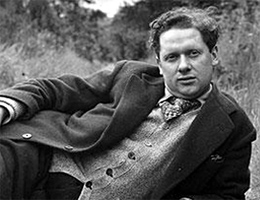Dylan Marlias Thomas, the greatest of the poets of Wales was born on 27th October 1914. He found out early that he hated academics, although he regretted it later. Dylan’s early verse style tended to unobscurity and exaggerated metaphor though he was a poet of villa and family. Dylan often set his listeners alive by his voice of elation and anguish ringing over their heads. In his own time Dylan was a myth and a legend who mesmerized large audiences through his poetry, his B.B.C. broadcasts and his recitations of his own poetry during his various lecture tours of the U.S.A. He came to be regarded as the greatest lyric poet of his age.
About the poem –
The poem is included in Dylan’s volume of poems entitled 18 Poems, 1934. It is re-working of material in the first two Swansea Notebooks which Dylan had commenced at the age of fifteen. However, the final shape of the poem was given in 1933, when the poet was only nineteen. This lyric brought him in the notice of the literary elite.
The present lyric is a complex work of art, and as such a number of themes and ideas stand out of it. It is characterized by ambiguity and admits of a number of interpretations. For example, the force that is celebrated in it may be the life force, the process of time, or the intensely felt sexual urge driving both man and nature to creative activity, as well as to death and destruction. The moment of fulfillment is also the moment of death. The lyric is difficult to understand because of its epigrammatic terseness and condensation. Much more is suggested than overtly mentioned, and the reader must read between lines to understand its full significance. Every successive reading is rewarding, for each time we discover new meaning and significances.
Use of the mythical technique (or successive parallels) enables the poet to enclose ‘vast immensities’ within a little space. T.S. Eliot used the mythical technique to draw parallelisms and contrasts between the past and the present, so that the past serves as a criticism of the present. Dylan Thomas has drawn parallelisms and contrast between man and nature – the macrocosm and the microcosm – so long as to bring out the superiority of man over nature. For example, man is conscious of the need to ‘tell’, while nature is moved by no such consciousness. Further, the lyric is built round a series of paradoxes. For example, the force which is creative is also destructive, eros (life force) and thanatos (death wish) are at work at the same time, love is both the source of life and death, and the womb is also the tomb; at the very moment of maturing, man also approaches death. The passing of the time brings death, but it also ticks, “a heaven round the stars”. ‘Fever’ is hot, but it is also ‘wintry’; the hot passions of youth are destructive and under their burden the poet is ‘bent’ even in his youth like an old man.
It is short lyric in four stanzas of five lines each. Two lines at the end which form the ‘coda’ or conclusion do not form a couplet as they do not rhyme, but they sum up the theme of the lyric and thus form a suitable conclusion to it. The particular stanza which has been used here was evolved by Dylan after many experiments, and is perfectly suited to his needs. The caesura, marked by a semicolon, in the second line, the falling cadence of the short third line, and the free-rhyming fourth and fifth lines (not a rhymed couplet, but involved by rhyme with the first lines) constitute the very form for falling and rising, a contention of opposites, and an agreement of parallels. The approximate rhymes, except for the feminine endings of the first stanza are regular in their irregularity until the last line of the third stanza, where ‘line’ rhymes with ‘time’, in the first line of the fourth stanza. The pattern of ababa, broken by ’line’ becomes aabab in the fourth stanza. Feelings of recurrence, variety and surprise seem effects of this scheme.
But rhyme is what chiefly moves us. The more or less regular first line, establishing the rhyme is counterpoised by the last two lines, which are as flexible as sprung rhythm as those of Hopkins. This flexibility, within strict form is one of the values of a thing that calls for reading aloud, preferably by Thomas. A concert of rhythms and sounds, this poem makes it seem likely that as early as this he was Hopkins’ pupil. Imagery of rope, sand and water supporting the clue of rhythm, recalls Hopkins’s The Wreck of Duetschland.
The structure is well knit and well organized without any looseness. This unity and coherence is not the result of logic but depends largely on statement and restatement in other terms, repetition with variation, a structure like that of nature itself, whose logic is not altogether ours. Oscillation between life and death, making and destroying, rising and falling, affords the movement. Pause is afforded by momentary condensation of contraries. Conflict and union also help. Our sense of regular process is aided, by verbal repetition. First lines except for that of the codas, begin with ‘The’. Fourth lines begin with ‘And’. Last lines, except for that of the first stanza begin with ‘How’.
The poem, “as allusive as something by Eliot, also recalls Blake’s, ‘The Sick Rose’, and most other readers, expected to make this association, have made it. We are also reminded of the cantered rose and taint-worm of Milton’s Lycidas.
Commenting on the traditional timeless quality of the lyric, Jim Hunter writes, “in this poem he is heavily loyal to the iambic pentameters and imagery of the early Shakespeare – ‘the crooked rose’, ‘the lover’s tomb’, the worm and the winding sheet. The subject matter of Thomas’s early poems is the traditional subject-matter of adolescence: a tormented immature sexuality, struggling to break the child’s bonds to the mother (perhaps felt in the second and fourth stanza of this poem), and a morbid horror of death and decay, linked by an aura of guilt to the frustrated sexuality. Much of the force of Dylan’s poetry is in its suggestiveness of these basic psychological pressures, rather than in its superficial statements. The poem is deliberately timeless in its cadence and imagery. Fuse is the only hint of the twentieth century, though the rhymes own some debt to Wilfred Owen.
Dear Readers- If this summary/analysis has helped you, kindly take a little effort to like or +1 this post or both. Make sure you like Beamingnotes Facebook page and subscribe to our newsletter so that we can keep in touch. We’ll keep informing you about stuffs that are really interesting, worth knowing and adds importance to you.
Some online learning platforms provide certifications, while others are designed to simply grow your skills in your personal and professional life. Including Masterclass and Coursera, here are our recommendations for the best online learning platforms you can sign up for today.
The 7 Best Online Learning Platforms of 2022
- Best Overall: Coursera
- Best for Niche Topics: Udemy
- Best for Creative Fields: Skillshare
- Best for Celebrity Lessons: MasterClass
- Best for STEM: EdX
- Best for Career Building: Udacity
- Best for Data Learning: Pluralsight














